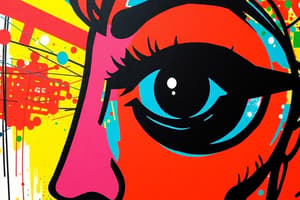Podcast
Questions and Answers
Who is considered the founder of pop art?
Who is considered the founder of pop art?
- Andy Warhol
- Roy Lichtenstein
- Richard Hamilton (correct)
- Paolozzi
Which artist used benday dots in their work?
Which artist used benday dots in their work?
- Paolozzi
- Richard Hamilton
- Roy Lichtenstein (correct)
- Andy Warhol
What was the main focus of pop art?
What was the main focus of pop art?
- Depicting famous celebrities
- Celebrating the ordinary (correct)
- Exploring traditional art techniques
- Promoting mass production
Which decade saw a rise in convenience foods and mass production?
Which decade saw a rise in convenience foods and mass production?
Which artist created diptychs in their artwork?
Which artist created diptychs in their artwork?
Which decade saw a rise in demand for convenience foods and mass production?
Which decade saw a rise in demand for convenience foods and mass production?
Who is credited with founding pop art?
Who is credited with founding pop art?
Which artist used collages in their work?
Which artist used collages in their work?
What did Andy Warhol's diptychs reference?
What did Andy Warhol's diptychs reference?
Which artist started using benday dots in their artwork?
Which artist started using benday dots in their artwork?
Flashcards are hidden until you start studying
Study Notes
Founders and Characteristics of Pop Art
- Andy Warhol is considered the founder of pop art.
- Roy Lichtenstein used benday dots in his work.
Techniques and Focus of Pop Art
- The main focus of pop art was on mass production and consumer culture.
- Pop art often used collages in their work.
- Diptychs were a common technique used in pop art, often referencing consumer culture and mass production.
Historical Context of Pop Art
- The 1950s saw a rise in convenience foods and mass production, influencing the development of pop art.
- The 1950s also saw a rise in demand for convenience foods and mass production, further shaping the pop art movement.
Studying That Suits You
Use AI to generate personalized quizzes and flashcards to suit your learning preferences.



